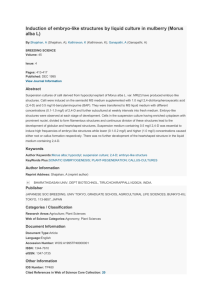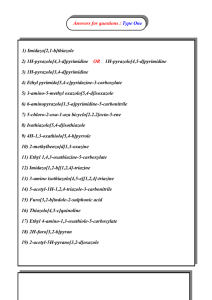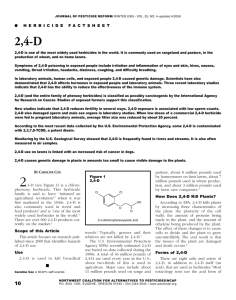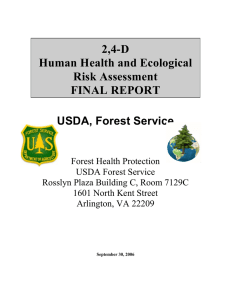315_A2 4D TB Users Guide
advertisement
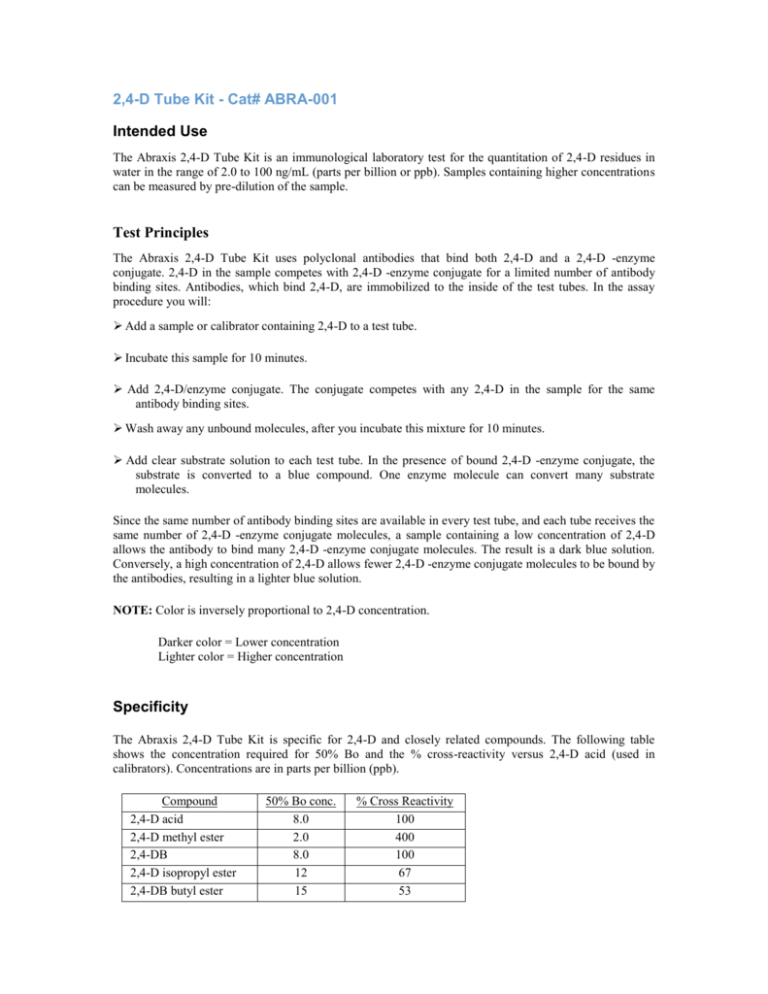
2,4-D Tube Kit - Cat# ABRA-001 Intended Use The Abraxis 2,4-D Tube Kit is an immunological laboratory test for the quantitation of 2,4-D residues in water in the range of 2.0 to 100 ng/mL (parts per billion or ppb). Samples containing higher concentrations can be measured by pre-dilution of the sample. Test Principles The Abraxis 2,4-D Tube Kit uses polyclonal antibodies that bind both 2,4-D and a 2,4-D -enzyme conjugate. 2,4-D in the sample competes with 2,4-D -enzyme conjugate for a limited number of antibody binding sites. Antibodies, which bind 2,4-D, are immobilized to the inside of the test tubes. In the assay procedure you will: Add a sample or calibrator containing 2,4-D to a test tube. Incubate this sample for 10 minutes. Add 2,4-D/enzyme conjugate. The conjugate competes with any 2,4-D in the sample for the same antibody binding sites. Wash away any unbound molecules, after you incubate this mixture for 10 minutes. Add clear substrate solution to each test tube. In the presence of bound 2,4-D -enzyme conjugate, the substrate is converted to a blue compound. One enzyme molecule can convert many substrate molecules. Since the same number of antibody binding sites are available in every test tube, and each tube receives the same number of 2,4-D -enzyme conjugate molecules, a sample containing a low concentration of 2,4-D allows the antibody to bind many 2,4-D -enzyme conjugate molecules. The result is a dark blue solution. Conversely, a high concentration of 2,4-D allows fewer 2,4-D -enzyme conjugate molecules to be bound by the antibodies, resulting in a lighter blue solution. NOTE: Color is inversely proportional to 2,4-D concentration. Darker color = Lower concentration Lighter color = Higher concentration Specificity The Abraxis 2,4-D Tube Kit is specific for 2,4-D and closely related compounds. The following table shows the concentration required for 50% Bo and the % cross-reactivity versus 2,4-D acid (used in calibrators). Concentrations are in parts per billion (ppb). Compound 2,4-D acid 2,4-D methyl ester 2,4-DB 2,4-D isopropyl ester 2,4-DB butyl ester 50% Bo conc. 8.0 2.0 8.0 12 15 % Cross Reactivity 100 400 100 67 53 2,4,5-T MCPA Dichlorprop 2,4,5-TP 84 86 300 360 9.5 9.3 2.7 2.2 The following list shows the compounds tested and found non-reactive at concentrations of 1,000 ppb (<0.1% cross-reactivity): Alachlor Azinphos Carbofuran Metolachlor Endothall Dicamba Aldicarb Bromophos Chlorpyrifos Parathion Atrazine Terbuthylazine Carbendazim Simazine Precautions • Store all kit components at 4°C to 8°C (39°F to 46°F) when not in use. • Do not freeze kit components or expose them to temperatures greater than 37°C (99°F). • Allow all reagents and samples to reach ambient temperature before you begin the test. • Do not use kit components after the expiration date. • Do not mix reagents from kits with different lot numbers. • Use approved methodologies to confirm any positive results. Materials Provided in the Abraxis 2,4-D Tube Kit 2 bags each containing 20 test tubes coated with rabbit anti-2,4-D antibodies and desiccant 1 vial each of 2,4-D calibrators corresponding to 0, 2.0, 10 and 100 ppb. 1 1 vial of 2,4-D -HRP Enzyme Conjugate vial of Substrate 1 vial of Stop Solution You also need these items: Photometer for reading absorbance at 450nm in 12mm x 75mm tubes. Watch or timer Clean running water or a wash bottle containing tap or deionized water. Pipet with disposable tips capable of delivering 500 µL Assay Procedure 1. Bring all kit reagents and samples to be run to room temperature. 2. Remove the required number of antibody coated tubes from the zip lock bag. Be sure to re-seal the bag with the desiccant to limit exposure of the tubes to moisture. 3. Pipet 500 µL of calibrators, control and samples into the appropriate tubes. Be sure to use a clean pipet tip for each solution to avoid cross contamination. 4. Incubate for 10 minutes at room temperature. 4. Add 500 µL of Enzyme Conjugate to each tube. 5. Swirl the tubes rapidly to mix the contents. 6. Incubate for 10 minutes. 7. After incubation vigorously shake the contents of the tubes into a sink. Flood the tubes completely with cool running tap water, then shake to empty. Repeat this wash step four times for a total of five washes. Invert the tubes on absorbent paper and tap out as much water as possible. 8. Add 500 µL of Substrate to each tube. 9. Incubate for 10 minutes. 10. Add 500 µL of Stop Solution to each tube in the same order of addition as the Substrate. 11. Read the tubes in a photometer at 450nm. If the photometer has dual wavelength capability, read at 450nm minus 605 or 650nm. 12. If the photometer has data reduction capabilities, use either a semi-log linear or 4 parameter curve fit. If manual data reduction is required, proceed with next section. Calculate Results 1. After you read all of the tubes, average the OD of each set of calibrators, controls and samples, and calculate the %Bo as follows: %B° = (average OD of calibrator, control or sample x 100) ÷ average OD of negative control 2. Graph the %Bo of each calibrator on the Y (linear) axis against its diazinon concentration on the X (log) axis using semi-log graph paper. Draw the best fit line through the calibrator points. 3. Determine the 2,4-D concentration of each sample by finding its %Bo value and the corresponding concentration level on the graph. Calculation of sample concentration is only valid if the %Bo of the sample falls within the range of the %Bo's set by the calibrators. If the sample falls outside of that range, the results must be reported as less than the lowest calibrator value or greater than the highest calibrator value. Sample Calculations Tube Contents OD Negative Control 2.0 ppb Calibrator 10 ppb Calibrator 100 ppb Calibrator 1.504 1.525 1.356 1.378 0.887 0.892 0.333 0.341 Average OD ± SD** 1.515 ± 0.015 %RSD %Bo 0.98 100.0 1.367 ± 0.016 1.1 90.2 0.890 ± 0.0035 0.40 58.7 0.337 ± 0.0057 1.7 22.2 Quality Control 1. The %Bo ranges for the calibrators should fall within the following ranges: 2,4-D Calibrator (ppb) %Bo Range 2.0 83 - 94 10 48 - 63 100 16 - 28 Technical Assistance For questions regarding this kit or for additional information about Abraxis products, call (215) 357-3911. Safety To receive complete safety information on this product, contact Abraxis, LLC. and request Material Safety Data Sheets.
